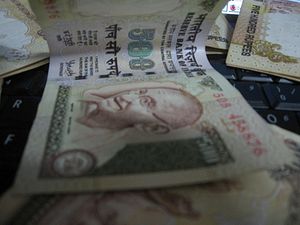Just under six months after Prime Minister Narendra Modi’s sudden decision to markedly reduce the amount of cash in circulation, the dust is now beginning to settle on arguably one of the boldest moves in Indian financial history.
Recent economic indicators suggest that the shock therapy administered through demonetization is defying expectations. The Reserve Bank of India recently reported growth of 7 percent for the fourth quarter of 2016, far exceeding economists’ forecasts of 6.1-6.4 percent. Not only does India remain the world’s fastest-growing major economy, it has outstripped Chinese growth in each of the last four quarters. At the same time, Modi appears to have strengthened his own position through some unconventional but effective political maneuvering.
The demonetization move can be fairly described as bold, because that is exactly what it was. India has withdrawn banknotes twice in the past – once in 1946 and again in 1978 – but the scale of this recent effort far surpassed anything before it. Overnight 86 percent of India’s cash supply – the equivalent of $220 billion – was effectively removed. The official intention was to combat corruption and terrorism. The wider objective, as stated by Modi’s Bharartiya Janata Party (BJP), was to force India and its 1.25 billion citizens to become part of the country’s digital economic grid. All of this in a country which pays 85 percent of its workers in cash – bold indeed.
The most striking aspect of the demonetization process has been its execution. Many India-watchers were enthralled by the unprecedented speed and secrecy of the move. That was highly unusual given the leaky nature of Delhi politics and its inquisitive press, but characteristic of Modi’s increasingly preferred style of governance. Only a handful of Modi’s aides were privy to his strategy. Working from rooms in the prime minister’s Delhi residence, the plans were hatched at breakneck speed – formulated within a nine-month period and announced dramatically in an unscheduled television address. Not even India’s banking institutions were aware of the plans, resulting in chaotic scenes at branches in the following weeks and stinging criticism from economists, businessmen, and politicians alike.
In the immediate aftermath, economists warned of the potential economic ramifications and rounded on the way in which the decision had been concealed and then suddenly executed. Accordingly, the manner of decision-making at the top of Indian politics has come under greater scrutiny. Modi has frequently bypassed his cabinet when making big calls, instead consulting a cabal of close aides. Alongside Modi, BJP President Amit Shah and Finance Minister Arun Jaitley make up India’s new “politburo” and they have been drawing up ambitious plans to reconfigure India as a more entrepreneurial and dynamic nation than ever before.
The broad consensus is that these moves signal a more centralized, Chinese-style of government, made possible by the BJP’s majority in India’s parliament and the overwhelming mandate Modi received in the May 2014 general elections. Detractors view his rule as increasingly autocratic, while supporters praise the speed with which decisions are made and executed in a country well-known for its often slow and cumbersome bureaucratic processes.
Nonetheless, it is still too early to assess the full impact of demonetization. That is more likely to be felt in 2017’s first quarter numbers, which could be worsened by apparently contradictory data. The Reserve Bank of India this month reported a sharp fall in consumer confidence at a time when growth has been reportedly driven by consumer spending. This has not been reflected in the earnings of India’s major FMCG players, leading some economists to question the accuracy of the government’s latest figures.
Notwithstanding these concerns, Modi’s reform and growth plans have their merit. The changes mooted to India’s Goods and Services Tax, which will unite the country’s fragmented market by streamlining the tax system, could be a near term game-changer. Set to come into effect on July 1, 2017, the system will be the first step toward the creation of a common national market, ensuring the free movement of goods across state borders and the reduction of the overall tax burden on domestic products and services. The IMF, along with other institutions, is particularly bullish about these tax reforms, and predicts the GST might push India’s growth trajectory toward 8 percent.
Meanwhile, Modi – likely emboldened by the BJP’s election victory this month in Uttar Pradesh, India’s most populous state – is forging ahead with bigger economic plans. He continues to court foreign investors, re-evaluate India’s energy and infrastructure needs, and reform cumbersome administrative structures. Whether doing this through his increasingly centralized model of governance will create further discontent remains to be seen. The issue may shape up to be one of the key battlegrounds in the 2019 elections. However, his policies thus far have been received warmly by domestic and foreign investors alike, leaving the premier with enough political capital to sustain him through his current term, at least.
Henry Burrows is an Associate at Alaco, a London-based business intelligence consultancy.

































